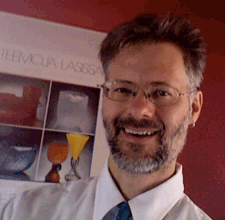Pilgrim Reindeer in Pisa, 1348
a free multimedia novel by
Thomas A. DuBois, University of Wisconsin-Madison
 |
Pilgrim Reindeer in Pisa, 1348 a free multimedia novel by Thomas A. DuBois, University of Wisconsin-Madison |
|
|
|
1. Part I Setting Out 1. Ovdal go buot/In the Beginning
I am glad to share this novel with you. It came about in a strange way. In 2007, my daughter Greer, then 14, decided that she wanted to learn Italian. So she and I signed up for basic Italian classes at the Italian Workmen's Club in Madison, Wisconsin, near the University of Wisconsin campus. We had a lot of fun learning the language and hearing about Italy.
Now, although I already knew French and Spanish and Latin, it was a strange thing that sometimes when the teacher said something in Italian to us, it sounded to me like northern Sámi rather than Italian. You may have had this sort of experience before when studying a foreign language; it happens, brain researchers tell us, because foreign language acquisition tends to take place in a single part of the brain, with each new language learned somehow building onto the synaptic pathways created by previous language acquisition experiences. So, anyway, I found this situation very, very strange, given that the words and phrases in Italian are so close to other Romance languages that I know well, and so far from anything in Sami, which is a Finno-Ugric language related to Finnish, Estonian, Hungarian and some other languages in Russia and Siberia. And further, sometimes, the Sámi phrases that came to mind made a lot of sense in the context we were discussing. For instance, when the teacher said: "Cosa vuole dire...?" (i.e., "What does this mean?") I would hear the Sámi "Kosa vuolggit?" ("Where are you headed?"), which in a certain sense meant something like the Italian. It made me imagine writing a text that would make sense in two distinct languages at the same time.
Well, after we had taken Italian for a while, I was planning a much-needed sabbatical. And then I received a call for faculty to apply to teach in the study abroad program that the University of Wisconsin runs with the University of Michigan and Duke University in Florence. After some family discussion, I decided to apply, and the next thing I knew, we were planning to move to Florence for a semester, where I would teach a course on pilgrimage and another on migration and identity in modern Europe. (Both of these topics play a part in the novel, as you will discover...) It was also the Pauline year, in which Christians the world over were encouraged to reflect on the travels of St. Paul and also visit, if possible, the cathedral dedicated to him in Rome.
The study abroad program that I joined is held in the beautiful Villa Corsi Salviati in the little town of Sesto Fiorentino, six miles outside of Florence proper. From the villa you can look out toward Mount Morello, and I ended up hiking around that mountain quite a bit with my kids Greer and Brendan. Some events in the novel take place on that mountain in particular. And here again, although I had learned a good deal of Italian, people sometimes seemed to be speaking Sámi when I overheard them, particularly young women flirting with their boyfriends....
While living in Sesto, we also had the chance to travel around Italy a little, and one weekend we set off for Pisa with Prof. Seymour (Sy) Mauskopf, an eminent historian of science and avid photographer from Duke University. There we ambled about the impressive buildings of the city's old Piazza dei Miracoli ("Square of Miracles"). Amid all the other treasures in that site, we came to the great fresco entitled "The Triumph of Death" which is described in this chapter and in the cultural information section as well. We had watched an art history lecture about this fresco in which the lecturer explained that the fresco reflected the pessimism and cultural devastation that developed in the aftermath of the Black Death of 1348. (In subsequent research, I found that other art historians date the fresco to well before the Plague year, but art historians, like other academics, sometimes play with chronology so that their favorite theories will work. They'll tell you, for instance, that the Scrovegni chapel was commissioned to reverse the slander brought about by Dante's portrayal of the donor's father Reginaldo degli Scrovegni in the Divine Comedy. Actually, of course, Giotto's phenomenal paintings predate Dante's phenomenal poem, but the story of the recuperative purpose of the grand chapel is just too appealing to set aside...) At any rate, while admiring this stunning, though much damaged, fresco, I noticed the figure of the milking monk. I took a photo, as did Sy, and sent it around to my Sámi studies colleagues in Scandinavia and North America as a curiosity.
Well, I guess the weight of it all was too great for me, and I started to feel the need to write a novel, an account that would explain the existence of a monk milking a deer in an Italian fresco and would help make sense of the strange linkages between Sámi and Italian cultures that I kept noticing. I wrote this preface first and read it to my wife Wendy Vardaman (a talented poet) and my discerning kids, and they agreed that it was worth continuing. In the subsequent weeks, I worked feverishly on the book, writing chapters that I read aloud to Wendy and the kids and also shared with our oldest son Conor, who was then a freshman at Boston University. They critiqued, asked for clarifications, and suggested improvements that helped me as I revised and expanded the work. During the spring of 2009, while on sabbatical, I finished the novel's first draft. So that's the story.